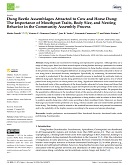| dc.contributor.author | Tonelli, Mattia | |
| dc.contributor.author | Giménez Gómez, Victoria C. | |
| dc.contributor.author | Verdú, José R. | |
| dc.contributor.author | Casanoves, Fernando | |
| dc.contributor.author | Zunino, Mario | |
| dc.date.accessioned | 2021-09-01T19:29:31Z | |
| dc.date.available | 2021-09-01T19:29:31Z | |
| dc.date.issued | 2021-08 | |
| dc.identifier.citation | Tonelli, M.; Giménez Gómez, V.C.; Verdú, J.R.; Casanoves, F.; Zunino, M. Dung Beetle Assemblages Attracted to Cow and Horse Dung: The Importance of Mouthpart Traits, Body Size, and Nesting Behavior in the Community Assembly Process. Life 2021, 11, 873. https://doi.org/10.3390/life11090873 | es_ES |
| dc.identifier.uri | https://repositorio.catie.ac.cr/handle/11554/11360 | |
| dc.description.abstract | Dung beetles use excrement for feeding and reproductive purposes. Although they use a range of dung types, there have been several reports of dung beetles showing a preference for certain feces. However, exactly what determines dung preference in dung beetles remains controversial. In the present study, we investigated differences in dung beetle communities attracted to horse or cow dung from a functional diversity standpoint. Specifically, by examining 18 functional traits, we sought to understand if the dung beetle assembly process is mediated by particular traits in different dung types. Species specific dung preferences were recorded for eight species, two of which prefer horse dung and six of which prefer cow dung. Significant differences were found between the functional traits of the mouthparts of the dung beetles attracted to horse dung and those that were attracted to cow dung. Specifically, zygum development and the percentage of the molar area and the conjunctive area differed between horse and cow dung colonizing beetles. We propose that the quantitative differences in the mouthpart traits of the species attracted to horse and cow dung respectively could be related to the differential capacity of the beetles to filtrate and concentrate small particles from the dung. Hence, the dung preference of dung beetles could be related to their ability to exploit a specific dung type, which varies according to their mouthpart traits. Moreover, we found that larger and nester beetles preferred cow dung, whereas smaller and non-nester beetles preferred
horse dung. This finding could be related to the tradeoff between fitness and parental investments, and to the suitability of the trophic resource according to the season and species phenology. | es_ES |
| dc.language.iso | en | es_ES |
| dc.publisher | MDPI, Basel (Switzerland) | es_ES |
| dc.relation.ispartof | Life, 11(9), 873 | es_ES |
| dc.rights | info:eu-repo/semantics/restrictedAccess | es_ES |
| dc.subject | ESCARABAJOS DEL ESTIERCOL | es_ES |
| dc.subject | ESTIERCOL DE CABALLO | es_ES |
| dc.subject | EXCRETA | es_ES |
| dc.subject | DIVERSIDAD FUNCIONAL | es_ES |
| dc.subject | SCARABAEOIDEA | es_ES |
| dc.subject | RASGOS FUNCIONALES | es_ES |
| dc.title | Dung Beetle Assemblages Attracted to Cow and Horse Dung: The Importance of Mouthpart Traits, Body Size, and Nesting Behavior in the Community Assembly Process | es_ES |
| dc.type | Artículo | es_ES |
| dc.identifier.status | openAccess | eng |


